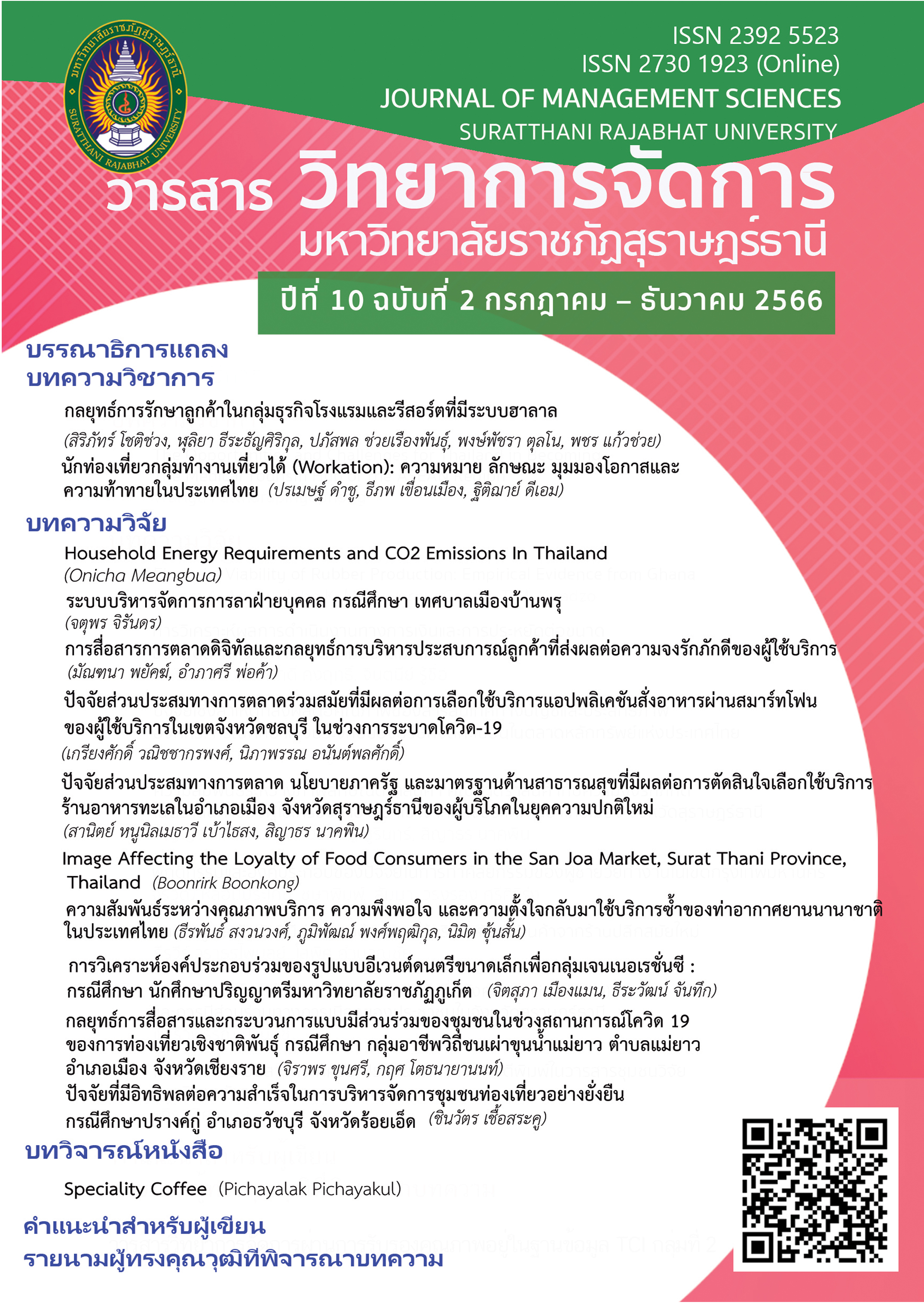ภาพลักษณ์ที่ส่งผลต่อความจงรักภักดีของผู้บริโภคอาหารในตลาดศาลเจ้า จังหวัดสุราษฎร์ธานี
Main Article Content
บทคัดย่อ
จากพฤติกรรมการนิยมรับประทานอาหารปรุงสดใหม่สำเร็จรูปของผู้บริโภคทำให้ตลาดอาหารริมทางมีบทบาทเพิ่มขึ้นอย่างมาก งานวิจัยครั้งนี้มีวัตถุประสงค์เพื่อศึกษาระดับความคิดเห็นเกี่ยวกับภาพลักษณ์อาหาร และภาพลักษณ์ที่ส่งผลต่อความจงรักภักดีของผู้บริโภคอาหารในตลาดศาลเจ้า จังหวัดสุราษฎร์ธานี เก็บรวบรวมข้อมูลด้วยแบบสอบถามจากผู้บริโภคชาวไทยอายุ 18 ปีขึ้นไปในตลาดศาลเจ้า จังหวัดสุราษฎร์ธานี จำนวน 400 คน โดยสุ่มเลือกแบบบังเอิญ วิเคราะห์ข้อมูลด้วยค่าความถี่ ค่าร้อยละ ค่าเฉลี่ย ค่าส่วนเบี่ยงเบนมาตรฐาน และวิเคราะห์ภาพลักษณ์ที่ส่งผลต่อความจงรักภักดีของผู้บริโภค ด้วยการวิเคราะห์การถดถอยโลจิสติก ผลการวิจัย พบว่า ผู้บริโภคส่วนใหญ่รับประทานอาหารประเภทก๋วยเตี๋ยว/โล้งโต้ง/ขนมจีนบ่อยที่สุด สัปดาห์ละ 1 - 2 ครั้ง ใช้จ่ายเฉลี่ยต่อครั้ง 101 - 150 บาท บริโภคบ่อยในวันจันทร์ถึงวันศุกร์ ในรูปแบบรับประทานที่ร้านและซื้อกลับ ผู้ที่ร่วมบริโภค คือ เพื่อน เหตุผลที่เลือกบริโภคในตลาดศาลเจ้า คือ ความหลากหลายของประเภทอาหาร ผู้บริโภคมีความเห็นต่อภาพลักษณ์อาหารโดยรวมในระดับมาก ภาพลักษณ์ที่มีผลต่อความจงรักภักดี ได้แก่ ความเป็นเอกลักษณ์และความคิดสร้างสรรค์ ซึ่งมีความสัมพันธ์เชิงบวกกับความจงรักภักดีของผู้บริโภคอย่างมีนัยสำคัญทางสถิติ แสดงถึงโอกาสที่ผู้บริโภคจะกลับมาซื้อซ้ำ ส่วนผู้ที่ไม่กลับมาซื้อซ้ำ คือ ผู้บริโภคที่เป็นนักท่องเที่ยว ผลการเสนอแนะเชิงนโยบาย ได้แก่ นโยบายอาหารและบรรจุภัณฑ์ที่เป็นมิตรกับสิ่งแวดล้อมและนโยบายอัตลักษณ์อาหารริมทาง งานวิจัยนี้จะมีคุณค่าต่อการพัฒนาภาพลักษณ์แต่ละด้านของอาหารในตลาดศาลเจ้าให้เป็นภาพจำของผู้บริโภค เพื่อความเป็นเอกลักษณ์ทางอาหารของจังหวัดสุราษฎร์ธานี
Article Details

This work is licensed under a Creative Commons Attribution-NonCommercial-NoDerivatives 4.0 International License.
References
Agmapisarn, C. & Decastro, N. (2018). Factors analysis of Thai consumer’s attitudes towards street food consumption: A case study of the victory monument roundabout area, Bangkok. Journal of Research and Development Journal Loei Rajabhat University, 13(45), 56-67.
Bangkheow, P. (2022). Thonburi Street Food: The Change of Urban Society for Sustainable Development. Journal of Art and Cultural Perception, 21(1), 145-165.
Boonklang, P. (2017). The organization image impact to customers royalty of bank for agriculture and agricultural co-operative: Dan khun tod brunch, Nakornrajasema province. [Unpublished master’s thesis]. Rajamangala Technology of North-East University.
Bualuang, C. (2021). Public polity: The model development of Process in Street Food in Lopburi Province. Thai Journal of Public Health and Health Sciences, 4(1), 175-190.
Bureau of Food and Water Sanitation, Department of Health. (n.d.). Development and elevation of street food standards. https://foodsan.anamai.moph.go.th/th/street-food/download/?did= 204151&id=70952&reload=
Cha, S., & Lee, S. (2021). The Effects of User Experience Factors on Satisfaction and Repurchase Intention at Online Food Market. Journal of Industrial Distribution & Business, 12(4), 7-13. https://doi.org/10.13106/jidb.2021.
Chaudhuri, A. and Holbrook, M. B. (2001). The chain of effects from brand trust and brand affect to brand performance: the role of brand loyalty. Journal of Marketing, 65(2), 81-93.
Cheng, B., Abu, N. K., Yap, C. S., Mansori, S., & Cham, T. (2022). Service-driven Advocacy: From Tourists’ Felicity to Preeminent Destimation Loyalty. Asian Journal of Business Research, 12(1), 124-146. https://doi.org/10.14707/ajbr.220123
Cheng, C. C., Chiu, S., Hu, H., & Chang, Y. (2011). A Study on exploring the relationship between customer satisfaction and loyalty in the fast food industry: With relationship inertia as a mediator. African Journal of Business Management, 5(13), 5118-5126. https://doi.org/10.5897/AJBM10.870.
Cochran, W. G. (1953). Sampling Techniques. New York: John Wiley & Sons.
Department of International Trade Promotion. (2018). THAIFEX – World of Food Asia 2018, https://gnews.apps.go.th/news?news=20106.
Ding, L., Jiang, C., & Qu, H. (2022). Generation Z domestic food tourists’ experienced restaurant innovativeness toward destination cognitive food image and revisit intention. International Journal of Contemporaty Hospitality, 34(11), 4157-4177. https://doi.org/10.1108/IJCHM-07-2021-0903
Jithpakdeepornrat, T., & Pooripakdee, S. (2021). The Effects of Street Food Identity on “Generartion Z” Customers’s Purchasing Intention, Satisfaction and Advocacy. Humanities and Social Science Research Promotion Network Journal, 4(1), 14-28.
Lamsiri, S., Tase, S., & Chawna, L. (2022). Factors Affecting Consumers’ Brand Loyalty towards Fast Food Restaurants in Bangkok. SSRU Graduate Studies Journal, 15(1), 68-86.
Oliver, R. L., (1999). Satisfaction: A Behavioral Perspective on the Consumer. New York: The McGraw Hill.
Poltanee, I. & Boonphetkaew, U. (2020). Structural equation model of positive psychology and consumer satisfaction of European backpacker tourists on street food at Yaowarat Street. Journal of Humanity and Social Science Journal Ubon Ratchathani University, 11(2), 205-224.
Rocharungsat, P. (2018). The model of image development for tourists’ royalty in Petch-buri Province. Journal of International Thai Academic, 14(1), 152-167.
Singh, G., Slack, N., Sharma, S., & Sharma, K., (2021). Antecedents involved in developing fast-food restaurant customer loyalty. The TQM Journal, 33(8), 1753-2731. https://doi.org/10.1108/TQM-07-2020-0163
Smitikrai, C. (2018). Consumer behavior (6th edition). Bangkok: Chulalongkorn University Press.
Sudari, S., Tarofder, A., Khatibi, A., & Tham, J., (2019). Retracted: Measuring the critical effect of marketing mix on customer loyalty through customer satisfaction in food and beverage products. Management Science Letters, 9(1), 1385-1396. https://doi.org/10.5267/j.msl.2019.5.012.
Suhartanto, D., Marwansyah., Muflih, M., Najib, M., & Faturohman, I. (2020). Loyalty formation toward Halal food Integration the Quality-Loyalty model and the Religiosity-Loyalty Model. British Food Journal, 122(1), 48-59. https://doi.org/10.1108/BFJ-03-2019-0188.
Surat Thani Municipality. (2018). Briefing document, Bureau of Public Health and Environment 2, Surat Thani Municipality.
Suwannarak, J., Pungnirund, B., & Sangma, W. (2021). Casual Factors Influencing Tourist Loyalty to the Consumption of Local Food in the Eastern Economic Corridor. Journal of MCU Peace Studies, (9)5, 1858-1870.
Uddin, M. (2019). Customer loyalty in the fast food restaurants of Bangladesh. British Food Journal, 121(11), 2791-2808. https://doi.org/10.1108/BFJ-02-2019-0140.
Watchana, D. (2017). The relation between image, service quality, and the royalty of the customers: Government saving bank in Surat Thani Province. [Unpublished master’s thesis]. Suratthani Rajabhat University.
Watcharin, N., & Anantachart, S. (2022). Lifestyle, Media Exposure, and Online Purchasing Behavior of Working-Age Female Consumers. Journal of Public Relations and Advertising, 15(1), 30-52.
Wuttipan, C., Kaewnuch, K. & Chaimongkol. W. (2019). International Tourist’ Perceived Value in Food Tourism Service: Street Food in Bangkon, Thailand. Dusit Thani College Journal, 13(3), 109-126.
Zhang, T., Chen, J., & Hu, B. (2019). Authenticity, Quality, and Loyalty: Local Food and Sustainable Tourism Experience. Sustainability, 11(3437), 1-18. https://doi.org/10.3390/su11123437
Zhong, Y., & Moon, H. (2020). What Drives Customer Satisfaction, Loyalty, and Happiness in Fast-food Restaurants in China? Perceived Price, Service Quality, Food Quality, Physical Environment Quality, and the Moderating Role of Gender. Foods, 9(460), 1-19. https://doi.org/10.3390/foods9040460

